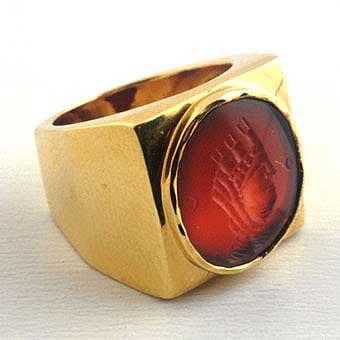Carnelian Intaglio Depicting the Deity Tyche, 100 CE - 300 CE
Carnelian, Gold
FJ.6004
The art of glyptic, or carving on colored precious stones, is probably one of the oldest known to humanity. Intaglios, gems with an incised design, were made as early as...
The art of glyptic, or carving on colored precious stones, is probably one of the oldest known to humanity. Intaglios, gems with an incised design, were made as early as the fourth and third millennia B.C. in Mesopotamia and the Aegean Islands. They display a virtuosity of execution that suggests an old and stable tradition rooted in the earliest centuries. The tools required for carving gems were simple: a wheel with a belt-drive and a set of drills. Abrasives were necessary since the materials used were too hard for a metal edge. A special difficulty of engraving intaglios, aside from their miniature size, was that the master had to work with a mirror image in mind. In Imperial Rome, members of the royal court and nobility often wore portraits of the emperor engraved on gems. Such tokens identified the political allegiance of the wearer and were sometimes given by the ruler himself as marks of special favor. One of the most popular images was the deity Tyche, who was the deified personification of Chance or Fortune. In a broad sense, Tyche was the synchronizing of power combined with providence and chance to which the world was subjected. Every city had its Tyche, depicted crowned with towers to symbolize her role as guardian of cities. On this beautiful intaglio she is much more personal; watching over for the person who wears her, gathering forces of the mythical past to bring luck and good fortune.



